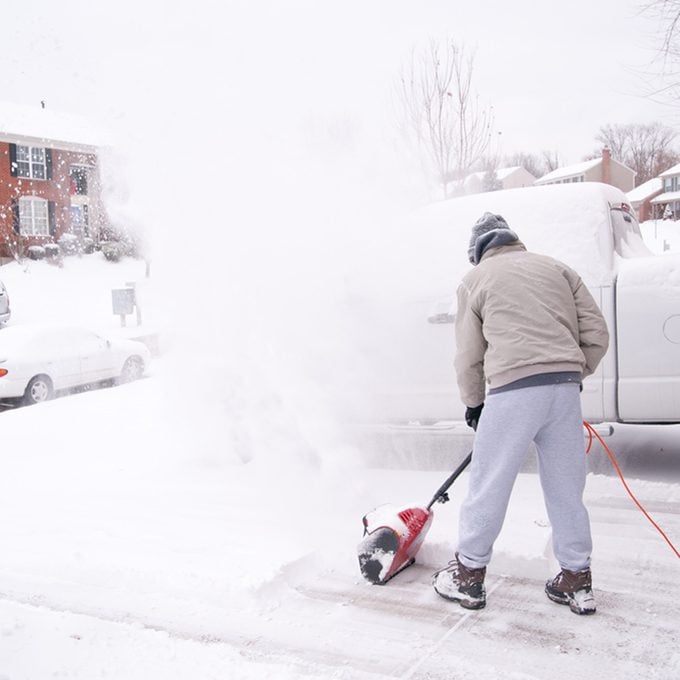Here's what to know before investing in an electric snow blower, according to industry experts.
Our editors and experts handpick every product we feature. We may earn a commission from your purchases.Learn more.
Here's what to know before investing in an electric snow blower, according to industry experts.
Our editors and experts handpick every product we feature. We may earn a commission from your purchases.Learn more.

You’ve decided you’re done with the snow shovel and are ready to invest in a snow blower—a fine choice. Electric snow blowers are a good option since they are eco-friendly, easy to operate and quieter than gas-powered models. Lou Manfredini, Ace’s Home Expert, notes that unlike gas-powered snow blowers, electric snow blowers require zero fluids or tune-ups, so they’re incredibly simple to maintain.
On This Page
There are tons of different electric snow blowers on the market, each with its own pros and cons. Here are some things to know before investing in the best electric snow blower for your yard:
“Gas units have been around for a long time,” says Manfredini. “They come in single-stage, two-stage, self-propelled and can handle all sorts of snow removal tasks from small to large depending on the size of a unit you use.”
According to Manfredini, gas also offers a virtually unlimited run time when the tank is full, and when it runs out, you just fill up and keep going.
“The downside is air pollution and engine maintenance. The cost of ownership can be modest to keep it running. But a well-maintained gas snow blower/thrower can last at least 10 years,” he says.
“Electric corded units are primarily for smaller jobs and must be plugged into an extension cord,” says Manfredini. “You can only go as far as the cord will reach, and you must be mindful of the cord so that you don’t run over it and chew it up.”
“Battery-operated snow throwers/blowers now have similar power to gas units. They come in single and two-stage and can handle big snowfalls as well,” he says. “Average run time on a full charge is about 45 minutes. With additional batteries on hand, simply switch batteries and keep going. No air pollution, a quieter unit and no motor maintenance required.”
Electric snow blowers are a good option when you need to clear snow no more than a foot deep. Since electric models are lightweight, they are good for cleaning off both walkways and driveways, along with snow on decks and patios where many gas-powered models won’t fit.
Unlike electric snow shovels which typically work best for mild to moderate winters, electric snow blowers come in various sizes and can accommodate most snowfalls.
“Snow blowers are for larger areas that need to be cleared of snow,” says Manfredini. “They are either single or two-stage units. Electric snow shovels are for clearing steps or a balcony and are either corded or battery-operated.”
Gas snow blowers need to have their oil changed and routine maintenance performed. Electric snow blowers are a little less fussy. Since electric snow blowers have no liquids that need to be changed or small parts that need to be cleaned, they are relatively maintenance-free. Just store the snow blower in a dry place to keep it running properly.
You’ll also want to remember to keep your extension cord untangled and hung up when not in use and check regularly for cracks and other damage.
Areas with heavy, wet snow are not the ideal conditions for an electric snow blower. Most electric snow blowers can’t handle as much snow as gas-powered models, so you may have to go out and use the electric model more often to keep the path clear. Instead, opt for one of the best-reviewed snow blowers.
According to our research, the best electric snow blower brands include companies that have been around for a while, like GreenWorks, Snow Joe, Ego and Toro.
“In my opinion EGO, Toro, and Dewalt are all good brands,” says Manfredini. “EGO is a battery-powered unit with the performance you’d expect to see from a gas unit. And EGO batteries work in all EGO tools, which makes using EGO outdoor products a great option for all four seasons.”
“Toro is well known for their gas units but also offer 60V snow throwers that will work with any of its 60V outdoor power tools,” he says. “The new DeWalt unit is part of its 60V battery platform, so this would be an option for those who might already have some DeWalt 60V outdoor power equipment tools to consider.”
I lived through a major home renovation in 2019, know the ups and downs of home improvement and love sharing tips with readers. Emily Way is an Associate Shopping Editor for Family Handyman with experience researching products and recommending the best designs to consumers. She researched and updated this piece. Way consulted Lou Manfredini, Ace’s Home Expert.
“Typically, you hold the safety handle and then push the start button to activate the motor. There is no pulling to start an engine like there is with a gas-powered unit,” says Manfredini.
Manfredini notes that you should first be sure to follow all the manufacturer’s safety guidelines.
“Cut a path through the snow you want to remove slowly, and then keep making additional passes engaging about 2/3’s of the clearing ability of the unit to allow maximum RPMs and to throw the snow farther,” he says.
“It all depends on the size, but they typically start at around $500 and go up from there,” says Manfredini.